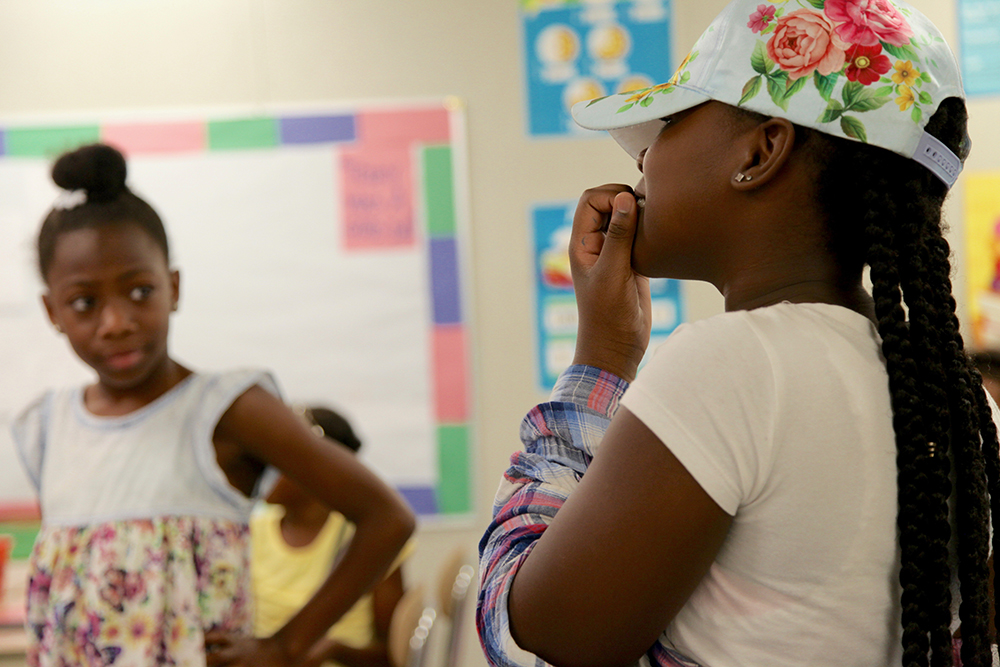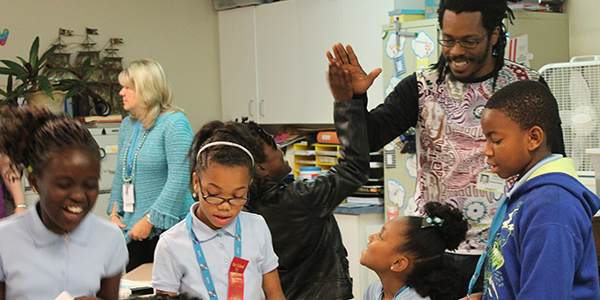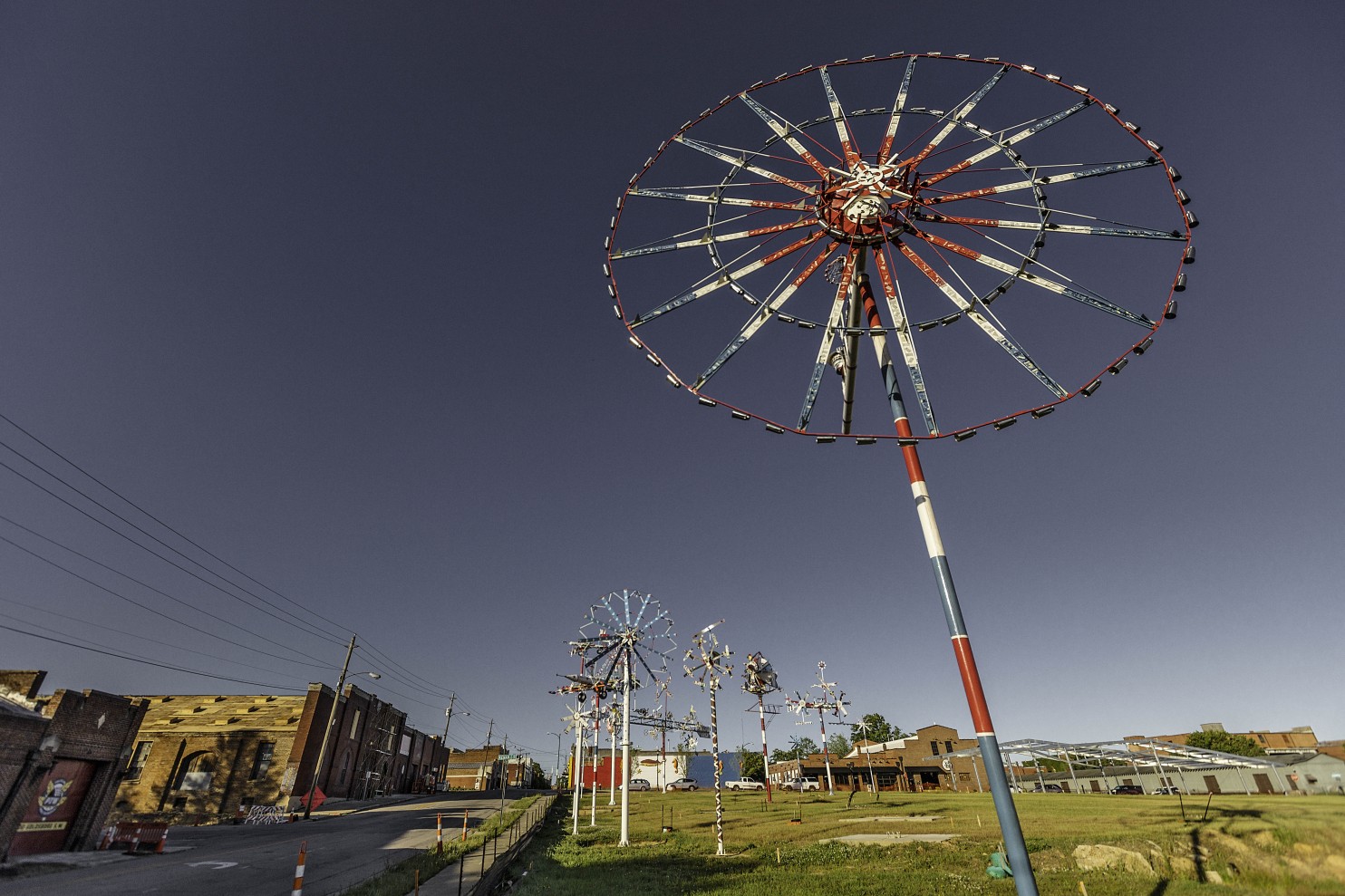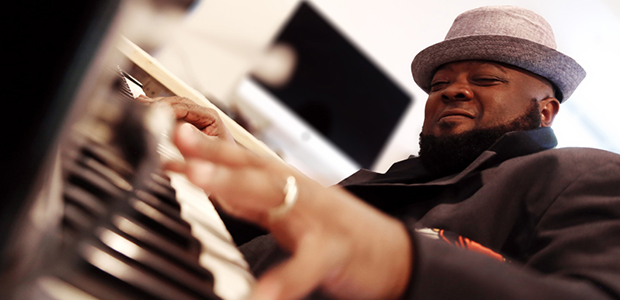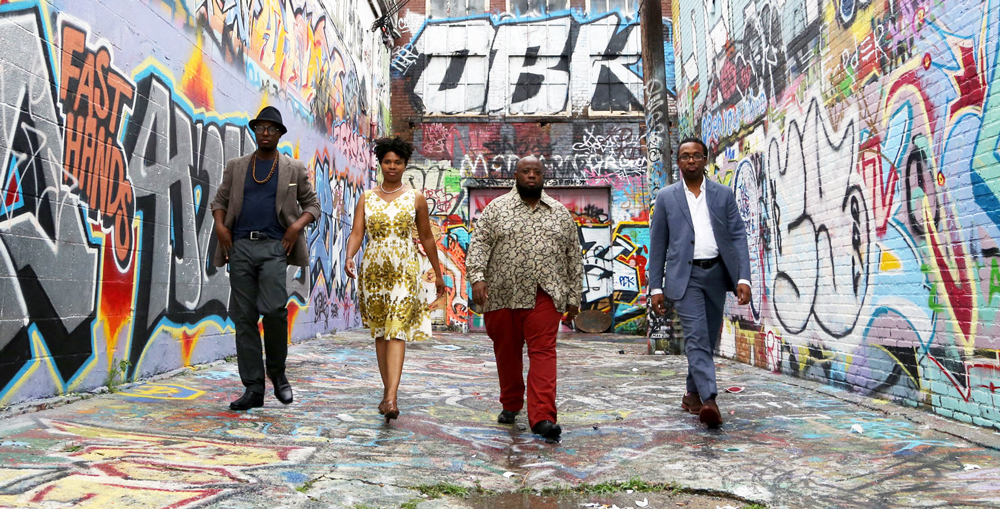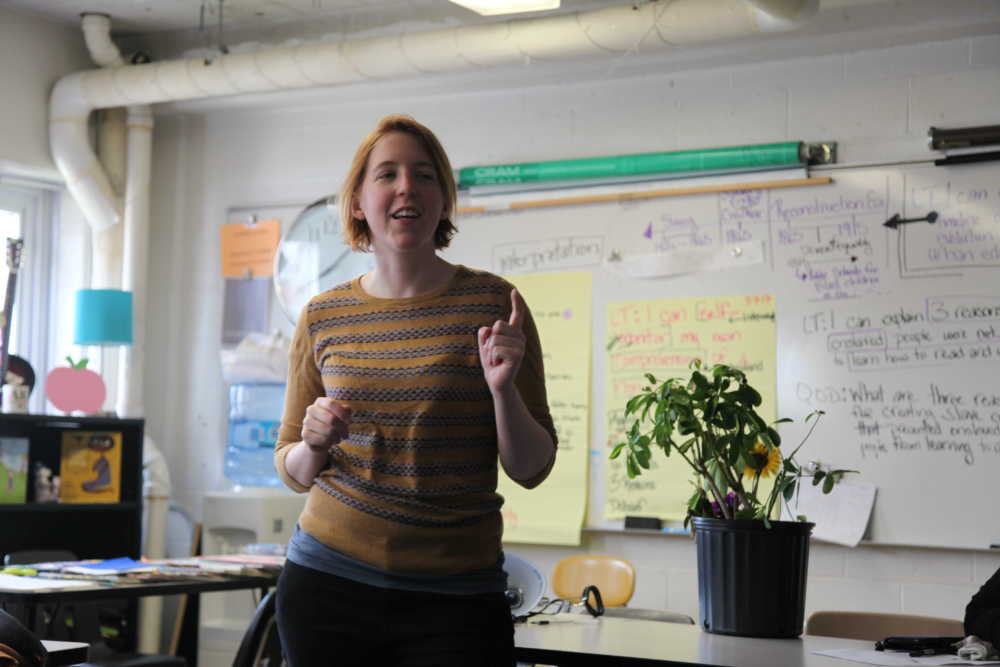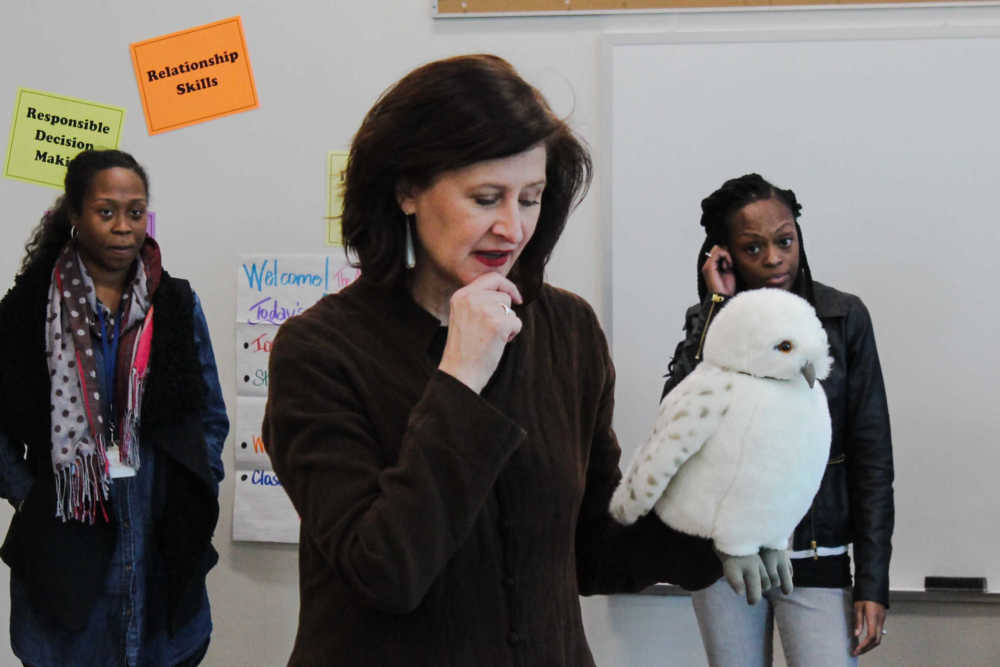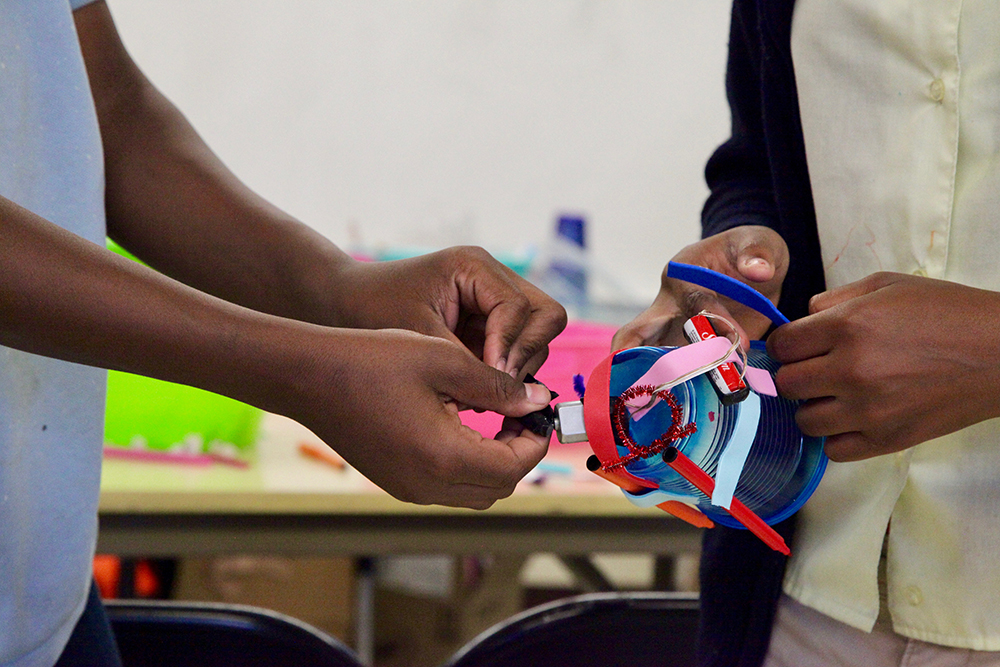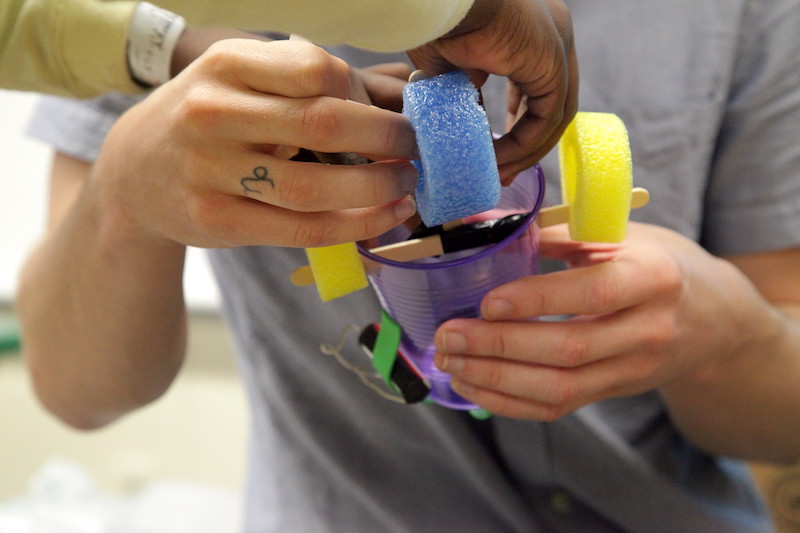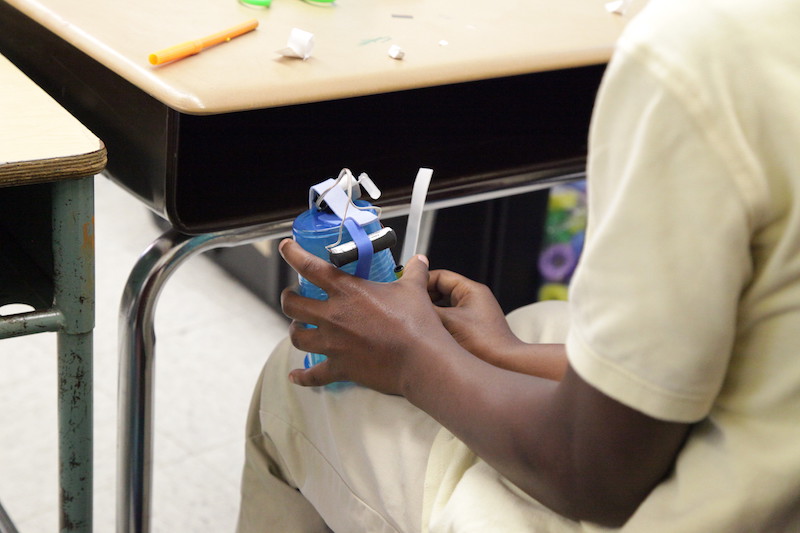Blog
Closing Out Summer: 1,100 Students Display Their Talents
Baltimore City School students closed out a summer of creativity and arts-integrated education with performances and visual art exhibitions at Young Audiences Summer Arts and Learning Academy. The academy’s culmination events were an opportunity for students to showcase their art forms and what they learned to family and friends.
The Summer Arts and Learning Academy took place over five weeks, giving students from Title 1 schools in Baltimore City a free, daily opportunity to explore art forms with teaching artists while improving literacy and math using hands-on, arts-integrated learning techniques. They wrote songs to memorize grammar rules, learned dances to recall fractions, and immersed themselves in a multitude of art forms, making literacy and math concepts stick. The third annual academy had children and staff laughing, learning, and inspired.

This kind of summer engagement with the arts is proven to have a significant impact on kids’ education. In Summer Arts and Learning Academy, classroom teachers and teaching artists work together to continue to build momentum while stemming summer learning loss, or the loss of academic knowledge over the summer months. According to a study last year by Baltimore City Schools, students in 3rd-5th grade attending the Summer Arts and Learning Academy avoided summer learning loss, and in many cases, gained ground on their national peers in literacy and math.

The culmination events, held at Thomas Jefferson Elementary/Middle, Coldstream Park Elementary/Middle, James Mosher Elementary, and Gardenville Elementary, put students on stage to showcase the art they created at the academy for parents, teachers, friends and family. Here is some of what we saw.
Two students from YA roster artist Femi theDrifish‘s spoken word poetry class read aloud their own inspiring words. They expressed the challenges caused by bullying through their writing, moving the audience with their heartfelt performance.
A larger group of students performed African dance on stage as their teacher, YA roster artist Ssuuna, led an accompanying rhythm section. A dance circle broke out at the end as students entered and showed the audience their skills. Cheers, laughs and applause filled the auditorium.

Music, poetry, and theater graced the stage as another group performed a chapter from a short story they read during the Academy. Kids performed as trolls and goats while their teacher, YA roster artist Drew Anderson narrated. Positive energy filled the room.

And that’s only a taste of the dozens of performances that took place at culmination events around the city. Watching students light up and enjoy learning with the infusion of arts experiences is remarkable. We can’t wait for next summer.
You can view images from all four of our summer sites by visiting our Flickr page. More information about Summer Arts and Learning Academy can be found on our website.
Donor Spotlight: Baltimore Gas and Electric Company
In 2016, Baltimore Gas and Electric Company (BGE) celebrated its 200th anniversary as the nation’s first gas utility in the country. With such deep roots in Maryland, BGE invests in organizations that support education, the environment, arts and culture, and community development programs. BGE has expanded its efforts in Carroll and Harford counties by partnering with organizations and programs that focus on children and education.
Young Audiences of Maryland is a natural partner for BGE. As Maryland’s leading arts-in-education organization, we are devoted to enriching the lives of Maryland’s youth through curriculum-aligned and culturally diverse arts programs. Young Audiences of Maryland is dedicated to ensuring that all communities, regardless of available resources or funding, have access to quality arts programs. In fact, with the support of public, private and individual sponsors, Young Audiences of Maryland is able to provide programs to hundreds of schools and community organizations throughout Maryland to ensure that all students have access to the arts. In 2016, with the support of BGE, we reached 11,711 students through 47 live performances and 185 in-depth workshops in underserviced communities in Carroll, Frederick, and Harford counties.
“BGE is proud to support Young Audiences of Maryland and its commitment to exposing children of all backgrounds to art, and using artistic expression as a means to promote diversity and inclusion,” said Denise D. Galambos, vice president of human resources for BGE and Young Audiences of Maryland board member. The great work that Young Audiences of Maryland is doing to help lift up our communities is extremely important and BGE is pleased to partner with such an organization.
Young Audiences of Maryland is grateful for BGE’s contribution to our work and for its commitment to the arts and education.
Learn more about how YA brings arts programs to rural communities. For more information about BGE’s charitable giving, please visit their website.
Summer Arts and Learning Academy: The Name Says it All
Written by Barbara Krebs,
Young Audiences volunteer and Sunburst Society member
Seedfolks. Bizz Buzz. These are just a couple of the new things I learned about when I visited the Summer Arts and Learning Academy at Thomas Jefferson Elementary/Middle School in Baltimore.
And learning through the arts is the whole point of this summer academy, now in its third year of operation. Young Audiences/Arts for Learning, in partnership with Baltimore City Public Schools, operates four of these academies at schools throughout the district as part of a system-wide arts-integrated strategy to reduce summer learning loss in literacy and math. Approximately 1,144 kindergartners through fifth graders take advantage of this free, fun-filled educational opportunity.
My first stop was to meet Site Director Kristin Taylor who manages the program at Thomas Jefferson. As we headed to the first classroom of fifth graders, she enthusiastically filled me in on the size of this particular academy (280 students), its average daily attendance (250 students), and the benefits provided at every site to help parents and kids (after-school care until 6:00 pm and free breakfasts and lunches served every day to each student).
As we walked through the halls, student-created posters, snippets of conversations, and the sounds of music offered glimpses of the learning that was taking place.
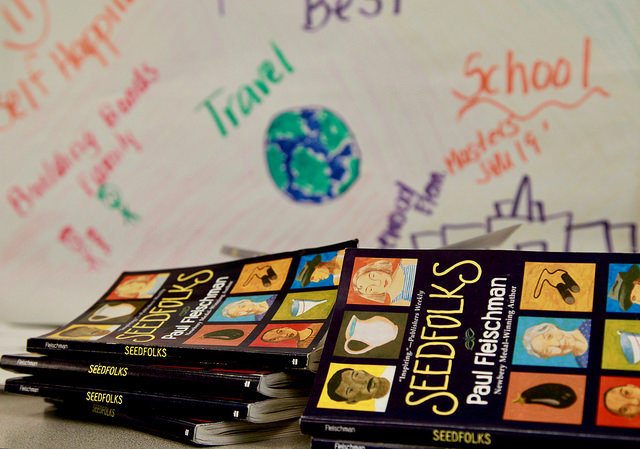
I entered the fifth-grade classroom of Ms. Paige and visual artist Mama Sallah just in time to watch a production of a chapter from Seedfolks, a book that shows how a neighborhood is transformed as people from different cultures interact in a garden. After the first group performed, I got a chance to ask Kenaya, one of the student actresses, about the book. She explained to me that each chapter of the book focused on a different character. The classroom had been divided into groups, each assigned to act out a different chapter of the book. These groups were to then silently act out what the narrator was reading.
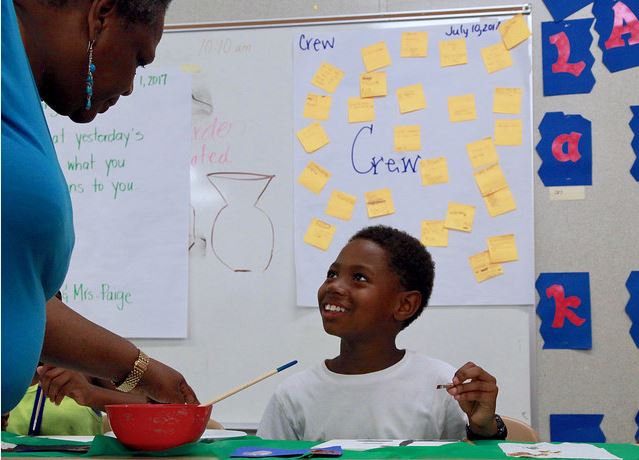
Kenaya’s group focused on Kim, a Vietnamese girl from the first chapter. The story starts with the girl staring at a portrait of her father. While one student narrated, others acted out the parts of Kim, the father’s portrait, and even more characters as the action moved into the garden Kim had planted.
I enjoyed watching their attention to the story and how each child handled their role, whether it was bending down to dig in the “dirt” or, like the young man playing the role of the portrait, staring silently into space, giving no indication that he was anything other than a photograph frozen in time. These were serious actors, hard at work.

The next classroom was quite a contrast. Ms. Chase and hip hop musician Jamaal “Mr. Root” Collier were teaching math to a mixed classroom of fourth and fifth graders, and I had arrived in time to witness a game of Bizz Buzz. The children formed a large circle in the room, then took turns doing math calculations in their heads, making sure their answer was either a multiple of three or five. Emotional sounds quickly filled the room: Squeals of excitement for the game, celebratory cheers as someone answered correctly, silence filled with tension and pressure as someone struggled to find the right number, and supportive classmates whispering, “You can do it!” and “You got this!”
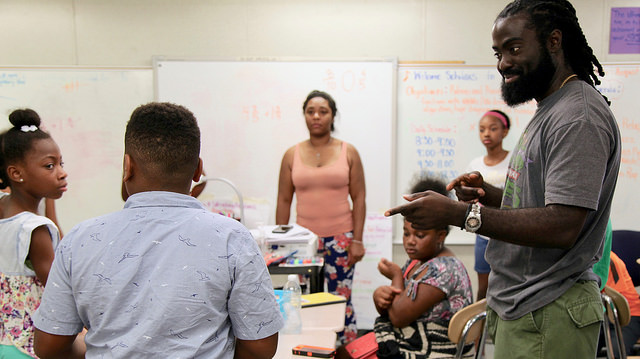
I have to admit I never did quite get the idea of when you yelled, “Buzz!” or “Bizz!” instead of a number, so I guess I’m going to have to admit that I am NOT as smart as a fifth grader. Luckily, they are!
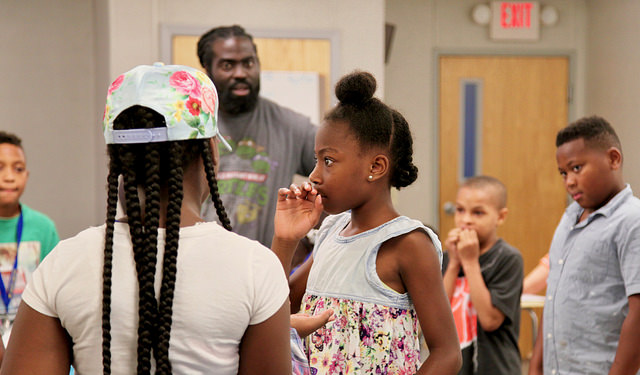
The next classroom was filled with third graders who were also working on math. However this time the class focused on word problems and measurements. Without the drama of Bizz Buzz, this classroom was much quieter with children working at their desks. As I wandered around the room, one outgoing and cheerful girl, Mikhia, came up to me. I probably looked a little lost because she explained to me what was going on – how they were learning about different cultures. I asked her if she liked the Academy, and she grinned broadly and nodded her head, yes.
“What do you like about it?”
“The teachers,” she answered without hesitation.
“What do you like about them?”
“They are nice, loving, and helpful. I’m learning so much this summer!”

The last classroom I visited was composed of first graders. I noticed a colorful picture on one boy’s desk of a volcano with a person going up the side of it and asked him about it. “Who’s that?” I asked, pointing to the person.
“That’s me,” Donald answered.
At that point, we were interrupted as it was time to line up for lunch. But before he left, I got another opportunity to ask him about his work. “Why are you walking up the side of the volcano?” I asked. He seemed a little confused but answered gamely, “I’m not walking, I’m flying.”
“Oh,” and now it was my turn to be a little confused. “You must be very powerful to fly.”
By now the girl in line behind him decided she had to help this poor confused person. Explaining patiently but emphatically, she corrected me. “It’s not powerful. It’s imagination!” At which point, I learned that their classroom was focusing on stories that dealt with imagination. So, yes, flying makes perfect sense. I’d rather fly over a volcano than walk up it, too!
As the children headed off to lunch, I thought about my first morning at Young Audience’s Summer Arts and Learning Academy and all the kindergarten through fifth-grade pros who had guided me through the learning process. I realized I had learned a lot, too.
For example, I learned that reading and acting out the story is a powerful way to concentrate on both the characters and the narration. I learned that math can be extremely riveting and exciting. I learned that different cultures can guide your math skills. And I learned that I need to let my imagination soar. But most importantly, I learned that combining arts with learning is fun – and effective – and that’s why the kids love it.

Hear Jazz Vocalist Renèe Georges on Young At Heart
On this month’s smARTbeats segment, Young At Heart host Lisa Mathews sits down with jazz vocalist, songwriter, and YA teaching artist Renée Georges. You’ll hear about the artist’s experience as a Raelette traveling the globe with Ray Charles and His Orchestra, as well as her work in schools where she shares her powerful voice and perspective with Maryland’s children, and guides them on a journey through the history of Jazz.

Renèe’s love of Jazz and interest in learning through music developed into a small family collaboration known as Kidz MusiQ Club. She had begun writing educational songs after her son was born to help kids have fun with essential concepts, such as reading, listening, and retention skills. The program she and her family created introduces kids to acoustic music and furthers an appreciation for jazz, all while learning about cool things like making healthy food choices and counting in Spanish. Renèe said, “When I was young, I used music methods, like making up songs about content, to help me study and remember things. Music is a great tool for retention. It improved my confidence and helped me become a better student.”
“The arts are a great way to cultivate excellence, for the beauty that is found through the arts, translates into life.”
In classrooms, Renée Georges unfolds the many facets of the music industry, presenting the field as a career option when it might not have been considered before. “For me, music was my path out of poverty. It also became a pathway for me to see the world since I was fortunate to sing and tour for six years with the late Ray Charles,” the artist explained. “Now more than ever, students have broader opportunities to forge careers as entertainers, arts educators, or even in sound engineering and physics.” Talking with Renée, kids realize that there are many paths related to music and the arts that are available to them.

She routinely advises students to be vigilant about copyrighting the work they create and to recognize that their work has value- a principle, she says, that would provide Ray Charles with a lucrative career for more than 50 years. “I first learned the value of copyrighting from my mother, who is also a singer/songwriter. She taught me the importance of protecting your work. My mother struggled as a single parent, but ownership fosters independence and can serve as a means to creating wealth. I like to help kids see that a little planning now can go a long way in setting up a career in the arts.”
During a question and answer period after her assembly at the Mann Residential School earlier this year, Renèe told students that music was her way to deal with hardship and adversity. “Along with learning to play the piano, reading books, and reading and writing poetry, the arts provided a way to cope with challenges like poverty, discrimination, and tragedy.” Moreover, she said, “The arts are a great way to cultivate excellence, for the beauty that is found through the arts, translates into life.”
Young At Heart airs weekly from 7 to 8 am on Saturdays, featuring music that appeals to parents and children alike. Previous shows have featured music by Wilco, David Bowie, Andrew & Polly, Weezer, and others.
Hear YA teaching artist and vocalist Renèe Georges online now!
Bomani Brings Hip Hop Poetry to Young At Heart
smARTbeats returns to WTMD this Saturday, July 8, during the weekly children’s music program Young At Heart. On this month’s smARTbeats segment, Young At Heart host Lisa Mathews sits down for a chat with Bomani. A seasoned performer, teaching artist, Director of Poetry Events for the Busboys and Poets restaurants, CBS Radio personality, and head audio-engineer for Urban-Intalek Studios, Bomani describes himself as a poet with a Hip Hop style.
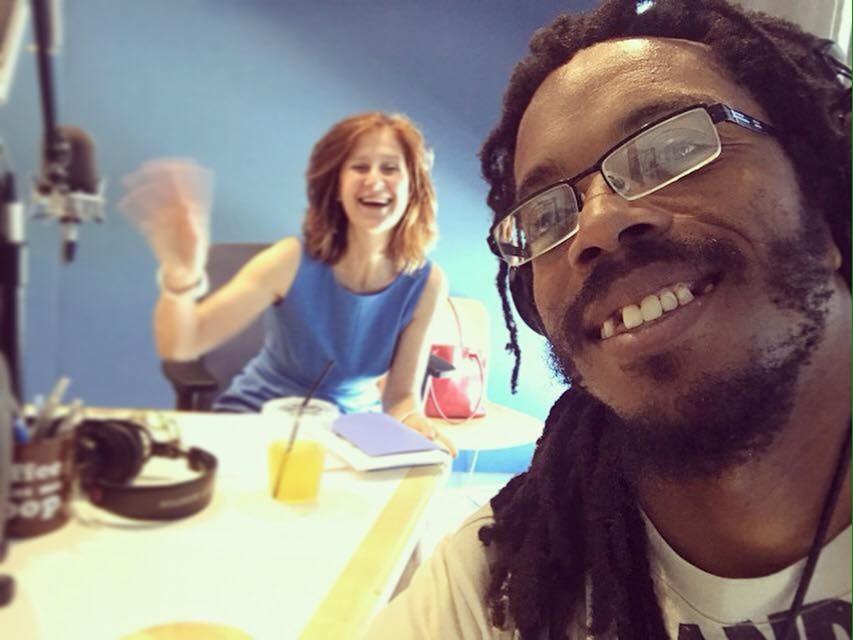
During the segment, you’ll get a taste of Baba Bomani’s Hip Hop poetry as well as hear about his experience in the classroom. The artist teaches creative writing and prose through the exciting world of Hip Hop songwriting. By first creating a fearless, supportive and collaborative environment, he instructs children to use elements of creative writing including simile, metaphor, and rhyme to structure a song written in the pattern of a well-written essay. “Young people need to have freedom to develop an idea out loud without self-doubt and to not fear right or wrong answers,” Bomani says.

“At the beginning of a residency, there are three writing rules I give students: Artists don’t make mistakes, they make discoveries; Do not edit in your head; The only wrong answer is a blank answer.”
“One of the reasons I love group creative-writing sessions is because the conversations that go on in a group setting are the same internal conversations that go on in a writer’s head. Showing that process to young people in a physical way, where they are acting out how ideas are communicated — ‘what about this idea, what about that idea, we should take this back, we should add that in there!’ — helps them to better understand complicated topics.”
Young At Heart airs weekly from 7 to 8 am on Saturdays, featuring music that appeals to parents and children alike. Previous shows have featured music by Wilco, David Bowie, Andrew & Polly, Weezer, and others.
Hear YA teaching artist and composer Bomani online now!
The National Endowment for the Arts: a Sound Investment
Co-authored by Barbara Krebs, a Young Audiences volunteer and Sunburst Society member.
We grow up in the United States hearing that we get what we pay for. Such is the case with investments in the greater good. That’s one of the many reasons we’re so passionate about teaching in and through the arts. From our country’s youngest students to our aging seniors, the entire population benefits in both the short- and long-term from the arts, whether it be emotionally, socially, or intellectually.
Non-profit arts organizations like us work hard to both generate sustainable programming and seek support from private and corporate funders so that we may fulfill our mission to positively impact the greatest number of Maryland children with the highest quality arts-integrated educational programming. Federal funding may only be a piece of our funding picture, but it is an important one.
We are excited and proud that the National Endowment for the Arts awarded Young Audiences of Maryland $90,000– one of only seven total Collective Impact Grants awarded nationwide– for the Arts Empowered Minds Initiative (AEMI) in Northern Anne Arundel County! The Arts Empowered Minds Initiative utilizes arts integration programming to boost achievement, parental involvement, student engagement, and empathy. Programming includes in-school arts integration, out-of-school arts programming, and professional development for teachers. In addition, the program will partner with community organizations to create family engagement opportunities, such as providing family passes to the new Maker Space at Chesapeake Arts Center.
The program is the culmination of the work of many groups and individuals seeking to build a movement for increased equity through the arts in their community. With funding from the NEA in 2016, we built partnerships with Anne Arundel County Public Schools (AACPS), Chesapeake Arts Center (CAC), Arts Education in Maryland Schools Alliance (AEMS), Arts Council of Anne Arundel County, and University of Maryland – Baltimore County (UMBC). Together, we have already provided professional development to over 100 teachers, and delivered high-quality arts-in-education programs to nearly 2,500 students at six schools.
“This second grant from the NEA will allow us to both deepen and expand our reach and maximize existing resources to ultimately bring the impact of arts integration to almost every student in Northern Anne Arundel County,” Stacie Sanders Evans, Executive Director of Young Audiences explained. The Arts Empowered Minds Initiative will expand from six schools to all 12 public schools in Northern Anne Arundel County and impact more than 7,000 students in grades pre-k through 12.
To be clear, it’s not the NEA’s budget that is proposed to be cut; it’s the NEA itself that is on the line. It’s important to think about this as it impacts local communities and groups. And, should the NEA be eliminated, it will impact our community. When vital, far-reaching, and life-altering programs are at risk, we must speak up. And it’s surprisingly simple and quick to let your voice be heard. Identify your legislators. Email your senator. Call your representative. Write a letter.
Take 2 minutes now to contact your members of Congress and join the #SAVEtheNEA campaign. Involved citizens can and do make a difference. Please, join us in the fight to keep the arts alive and accessible in our nation, state, and community. We get what we pay for. And, when we invest wisely, what we get is more than we could have ever even hoped for.
Arts Budgets, Job Creation, and the NEA
Written by Barbara Krebs, a Young Audiences volunteer and Sunburst Society member
With all the talk of entirely eliminating funding for organizations such as the National Endowment for the Arts (NEA) from the federal budget, a recent Washington Post Magazine article caught my attention. The June 11, 2017 issue featured a boldly colored cover and the caption, “Is Arts Funding Essential or Wasteful? We traveled the country to find out.”
I was especially intrigued since one of the arts projects they highlighted was in Wilson, NC – where I lived as a teenager. I admit that I haven’t been back in many years, but I had heard from friends that the town had fallen on hard times as tobacco warehouses (once the backbone of the economy) closed down.
The article opened with the development of Whirligig Park, which is dedicated to the artwork created by Vollis Simpson, who fashioned giant whirligigs out of scrap metal that he collected from his day job of transporting houses and heavy machinery. Before his death in 2013, Simpson had gained quite a following; the man and his artwork had been featured in publications that range from The New York Times, USA Today, The Washington Post, and the Smithsonian Magazine, among many.
As I read the Post article, it highlighted how the NEA had been “an early believer in the civic power of Simpson’s creations.” With the help of the organization and its grants, locals also began seeing the possibilities – to draw tourists and their dollars to Wilson – and skeptics gradually became believers. People who had originally viewed Simpson’s whirligigs as junk now began to see how the arts could help revitalize a moribund downtown.
But just as all politics is local, so too are the arts. You focus on where you live. With that in mind, a quick check of the NEA web site revealed that in the Fall of 2016, 19 grants, totaling $520,000, were awarded to a variety of Maryland arts groups. And while these groups range widely in mission and artistic focus, two things stood out: 1) how many of these groups reach out with the arts to educate and 2) these NEA grants create much-needed jobs.
Over the years NEA support has made it possible for Young Audiences to reach children in every county in our state…
Under the education category, award recipients include the Baltimore Symphony Orchestra’s OrchKids program, which provides Baltimore City Public School students with a music and mentorship program; Wide Angle Youth Media, Inc., which teaches students how to share their voices through media arts education; The National Association of Black Storytellers, Inc., whose Adopt-A-Teller Program places African American storytellers in schools for performances and workshops to share and preserve the rich heritage of the African Oral Tradition; Arts on the Block (AOB) who provides teens in and around Montgomery County real-world work experiences through the arts; and World Arts Focus in Mount Rainier, for a program developed improve the health, identity, and independence of teenagers and adults with autism, Down syndrome, cerebral palsy, or other disabilities through dance.
Over the years NEA support has made it possible for Young Audiences to reach children in every county in our state and has provided consistent support for teaching artist training, ensuring that our programs are not only accessible and affordable to underserved students, but are of high quality and enhance the curriculum of our schools.
What about the job creation category? Here are a few thoughts on the economic impact of the arts in our communities.
- Employment opportunities – we’re not just talking artists and dancers here. The arts also employ carpenters, electricians and many other technical and administrative jobs needed to produce showcases, exhibitions and museum presentations.
- Arts education – at Young Audiences we see every day, firsthand, what a huge impact the arts have in helping students connect to reading, math, and science. Educated youth become educated adults with jobs that create a tax base.
- Tourism – Many struggling small towns, and even larger cities, have boosted the local economy by creating arts zones, which draw in tourists, which, in turn, creates the need for restaurants, hotels, and other tourist-oriented businesses.
So what lesson can we take from all this? I think it is simply that the arts do matter – a lot. The arts help create and maintain vibrant community ties, which in turn translates into real economic impact. Before the Post Magazine article caught my eye, I had read an article in the April 2017 issue of Our State, Celebrating North Carolina. I read about 217 Brew Works, which opened last November, hmm, across the street from Whirligig Park. Tourists certainly enjoy the proximity of the brewery to the park, but more importantly, locals are the true economic boosters – coming down to talk, to relax and to enjoy their community’s new meeting spot.
It’s also worth noting that when the arts are supported, great synergies are created. For example the Our State article ended with, “another developer has moved forward with plans to create Whirligig Station – apartments, restaurants, and some office space – in an empty red-brick tobacco warehouse on another edge of the park.”
Far from being an unnecessary frill as some critics of the NEA portray it, what is readily apparent is how many small communities discovered an economic lifeline from the grants that the NEA provides. The closed factory, the shuttered mill, the abandoned plant are sadly a fact of life in too many small towns. But as many of them have discovered, there are opportunities here as well. Who knows what might happen in your community when you combine artistic vision, a good beer, and an NEA grant?
Coming up on the June edition of smARTbeats on WTMD: pianist and composer Scott Patterson
smARTbeats returns to WTMD this Saturday, June 10, during the weekly children’s music program Young At Heart. On this month’s smARTbeats segment, Young At Heart host Lisa Mathews sits down for a chat with Scott Patterson, pianist, composer, YA teaching artist, and co-founder and Artistic Director of Afro House, a music-driven performance art house based in Baltimore.
During the segment, you’ll hear Scott Patterson’s luxuriant blend of classical, soul and rock music, which Pittsburgh Tribune-Review describes as “a masterly blend of virtuosity, singing style and beautiful voicing” and learn about his work as a performing and teaching artist, and how the arts can impact the lives and education of children.
“As a performer and composer, I put my entire being, passion, and skills into telling a story.” Scott says, “Doing so enables me to take the audience on a journey to transcend limitations and transform the heart. My approach to creating and performing extends to my work in schools. As a teaching artist, I have seen firsthand the positive impact of arts education on students.”
In schools, Scott Patterson welcomes students into his assembly performance Outer Space Improvisations with the sounds of space, immersing students in original space-themed compositions inspired by composers and artists such as Beethoven, Liszt, Earth, Wind & Fire, Led Zeppelin, Jimi Hendrix, Maroon 5, and Bruno Mars. To expand the connection, facts about space are woven in throughout the program to deepen their intergalactic experience.
Patterson says one of the reasons he joined the Young Audiences teaching artist roster was a fond memory of the school assemblies he attended as a child. “Whether the assembly was about public safety or a performance, the message always stuck with me. Assemblies were presented as something special, a time to get out of the classroom and see information presented in a fun and interesting way. It is my hope that Outer Space Improvisations leaves the same kind of positive impression on students as the assemblies I attended as a child.”
“Through music,” Scott says, “I encourage students to see the convergence of academic disciplines, rather than single out one in particular. In using improvisation activities, I invite students to pull from what they know about math, literature, science, and history to create something entirely new and unique.”
As a performing artist and co-founder and Artistic Director of Afro House, Patterson and his team are “committed to the development of a music culture that is disruptive, exuberant, innovative, emergent, and transformative.” At the center of Afro House stands the Astronaut Symphony, a contemporary music ensemble that creates symphonic performance art pieces, such as Patterson’s sci-fi tone poem, Ebon Kojo: The Last Tribe. Recently, the Astronaut Symphony was in residence at Single Carrot Theatre and NextLOOK and most recently performed during Nights on the Fringe at The Baltimore Theatre Project.
A Piano Performance major, Patterson studied under Richard Fields at the University
of Cincinnati’s College-Conservatory of Music and Phillip Kawin at the Manhattan School of Music.
Young At Heart airs weekly from 7 to 8 am on Saturdays, featuring music that appeals to parents and children alike. Previous shows have featured music by Wilco, David Bowie, Andrew & Polly, Weezer, and others.
Hear YA teaching artist and composer Scott Patterson online now!
Congratulations TAI Graduates!
We all know that artists can change the world. The Summer Arts & Learning Academy is proof of that. The Teaching Artist Institute (TAI) helps give artists the tools they need to do it.
“Participating in TAI allowed me to look past what was most commonly done, embrace my artistic instincts, and focus on what really matters,” said Maura Dwyer, one of the Teaching Artist Institute’s newest graduates. “Instead of teaching students how to paint, I am teaching them how to think visually.”
During the course of the programs, artists worked with classroom teachers to design arts-integrated and Common Core-aligned fine arts programs for schools. Each TAI team designs and implements an artist-in-residence program in which teachers gain arts skills and artists gain valuable teaching skills. Topics such as classroom management strategies, designing, writing, and teaching artist-in-residence lessons, and educator needs are covered, as well as opportunities for field testing and feedback.
Congratulations to the following artists and teacher partners who completed the TAI seminars in May 2017!
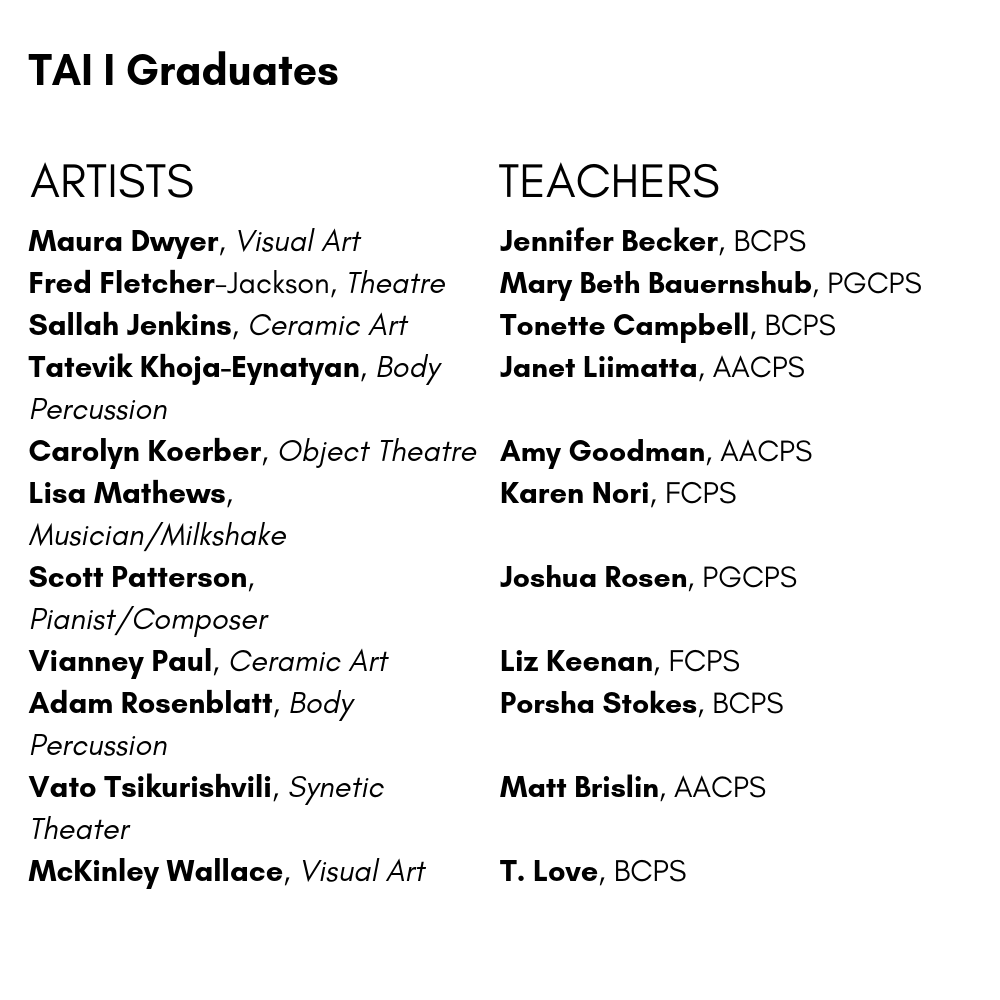
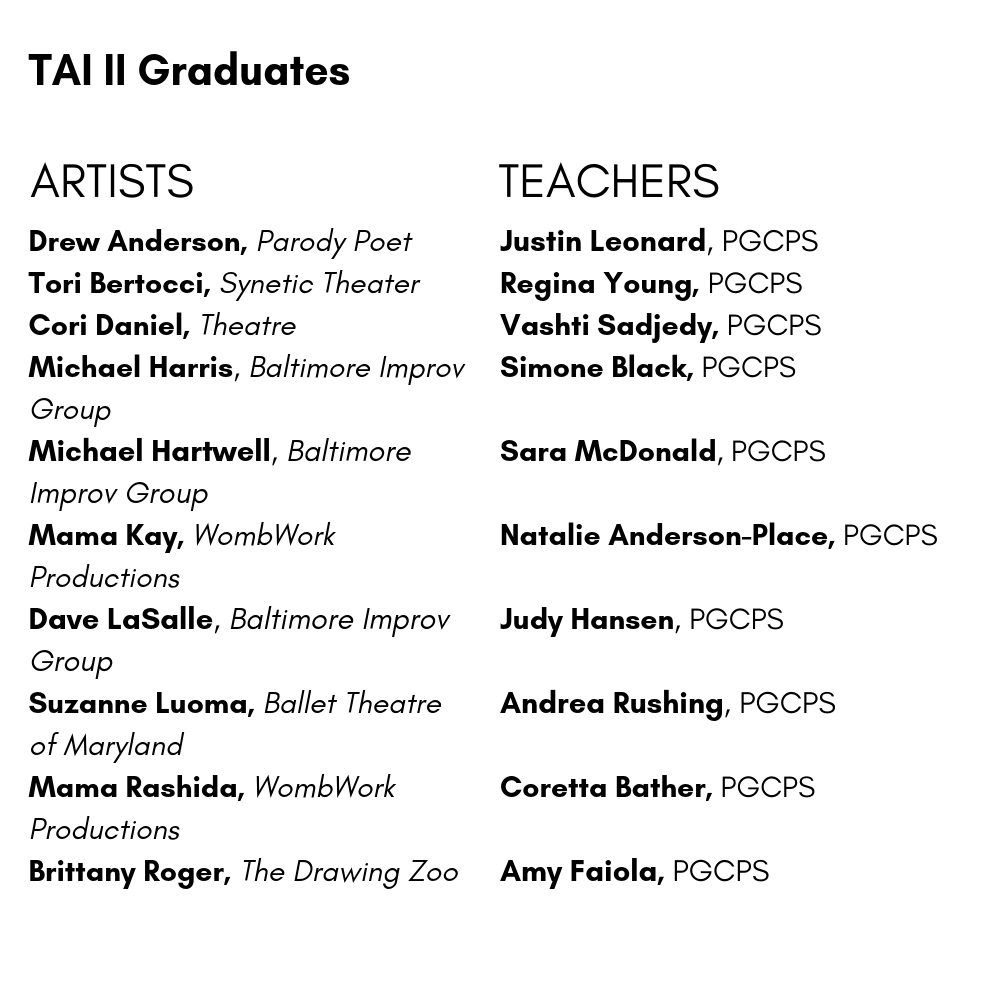
Next summer we are going to need even more qualified teaching artists to work at our academy. Apply to the Teaching Artist Institute by Friday June 9 to be trained and considered for summer 2018! New artists who successfully complete TAI, graduate from the program, and meet additional requirements, will not only be hired for our summer program, their tuition will be reimbursed!
Changing Perceptions: I Used to Think…
Written by Barbara Krebs, a Young Audiences volunteer and Sunburst Society member.
Colorful sticky notes adorned the walls of the classroom. Like before-and-after photos of an amazing remodel, the notes told the story of how a group of Head Start teachers in Southern Maryland unveiled their hidden talents to reach their young students through the arts. The ‘before’ stickies began, “I used to think…” Teachers filled in the rest of the sentence with thoughts such as, “dance, music and theatre weren’t that effective,” or “movement and story time could not go together,” and “it was hard to integrate the arts into the classroom.”
Then, as Young Audiences teaching artists demonstrated techniques that blend learning and the arts, the Head Start classroom teachers began making their own artistic/educational connections – connections that would help them return to their classrooms and engage kids in ways they had been hesitant to trust before. They soon realized that when kids are singing, dancing, and moving, it’s easy for them to forget that they’re actually learning!

The Professional Development course was held on February 17th and sponsored through the PNC Grow Up Great® initiative. Created to help children from birth through age five develop a passion for learning that lasts a lifetime, the program generously funded training that provided Head Start teachers with a variety of resources to increase learning, engagement and confidence by incorporating art into the curriculum.
Three YA teaching artists, musician Lisa Mathews, actor Khaleshia Thorpe-Price, and dancer Anna Menendez, taught the group. They learned, for example, how to use dance tools to create patterns, how to use their bodies and musical instruments to express themselves, and how the use of props and different character voices can more fully engage students in story time. At the end of the class, each teacher was tasked with writing and presenting a lesson seed in each art form for when the class reassembled in May.

“It was very evident from their participation on the first day and their reflections on the second day that teachers were excited about these arts strategies and implemented them immediately,” explained Kristina Berdan, YA’s Education Director. “Having strong backgrounds in social and emotional learning, they were able to quickly experience and understand the impact that the arts can have on this kind of growth in young people. Most of them tap into the arts regularly through chants and songs, yet these professional development opportunities allowed them to learn deeper, more meaningful strategies in and through the arts. The ‘ah-ha’s and feelings of excitement were palpable!”

For some, wariness about the role arts could play in the classroom had been replaced with a newfound willingness to incorporate them into their lesson plans. Through the introduction of dramatic play and puppetry, for example, students had a greater understanding of the stories they read in class than they did before the professional development course. One Head Start teacher, Jessica Wiley, summed up her experience in YA’s Professional Development class this way, “The ideas and suggestions were practical, applicable, and personalized. I love how Young Audiences was able to address our questions, challenges and concerns very well.”
The teachers ended the day completing sentences on sticky notes that began, “Now I think…” Their statements showed how their opinions about using the arts as a tool for learning had evolved from hesitancy to a feeling of openness and anticipation, writing, “you can use music in all areas of teaching,” and “dance can be a calming technique,” or “movement in story time is helpful to keep children engaged.”
For Maryland’s youngest students, the new strategies will be especially impactful. “Head Start supports our nation’s most vulnerable children by offering a comprehensive, high quality early-learning experience that prepares them for kindergarten and strengthens family participation in their children’s learning,” said Yasmina S. Vinci, executive director, National Head Start Association.
Like any successful renovation, the before-and-after sticky notes showed what can be created when you effectively blend harmonious elements – education and the arts – to capture a child’s natural desire to learn.
Baltimore City’s First Bloomberg Arts Internship Recipients Announced
The Bloomberg Arts Internship program is coming to Baltimore this summer, placing 25 Baltimore City rising seniors in paid internships at 14 local arts and cultural institutions. Students will participate in a rigorous six-week program, providing crucial college and career readiness preparation through hands-on, real world workplace experiences and professional development.
Managed by Young Audiences/Arts for Learning and the Greater Baltimore Cultural Alliance (GBCA), the program includes work at an arts organization, visits to arts and cultural organizations, and professional development training. The Baltimore Bloomberg Arts Internship Program runs June 20-August 4, with Baltimore being the third city to host the program along with New York City and Philadelphia.
Participating institutions include performing arts centers focusing on dance and music, art museums, libraries as well as film festivals and television studios. The organizations welcoming Bloomberg Arts Interns include:
Baltimore Center Stage
Baltimore Museum of Art
Baltimore Symphony Orchestra
Center for Innovation, Research and Creativity in the Arts (CIRCA) – UMBC
Dance & BMore
Everyman Theatre
Hippodrome Foundation, Inc.
Maryland Film Festival
Maryland Institute College of Art (MICA)
Maryland Public Television
Peabody Institute of The Johns Hopkins University
Port Discovery Children’s Museum
The Reginald F. Lewis Museum of Maryland African-American History & Culture
Sheridan Libraries and University Museums, Johns Hopkins University
“Through our arts internship program, we’re working to change how the next generation of employees and leaders perceive cultural institutions’ contributions to a city’s workforce, economy, and identity,” said Patricia E. Harris, CEO of Bloomberg Philanthropies. “As part of the program, interns will develop critical workforce skills at select non-profit cultural organizations, meet with professionals in the field, and attend career and college readiness workshops as part of their summer experience. We are delighted to expand this program to Baltimore.”
The 25 Bloomberg Arts Internships interns were selected through a multi-step application and interview process. They will work with arts organizations three days a week, go on field trips to cultural institutions once a week, and engage in professional development trainings once a week. Through the internships and trainings, students will develop organizational work plans, begin their college applications, write analyses of art performances, and complete final projects on their experiences. Internship focuses vary across organizations to include production, education, development, community engagement, artist engagement, video, music, administration and more.
“The arts have the power to transform lives and the futures of students in our community,” said Stacie Sanders Evans, Young Audiences Executive Director. “Through their generous investment in Baltimore, it is clear that Bloomberg Philanthropies not only agrees, but also can see the vibrant, growing community of artists and organizations that make this city unique. We’re thrilled to coordinate this wonderful opportunity, providing Baltimore students with experiences showing the arts as a viable career pathway and passion. We can not wait to see how this program impacts the ideas and dreams of these interns.”
“GBCA is excited to be part of this new project,” said Jeannie Howe, GBCA Executive Director. “The Bloomberg Arts Internships will help young people develop workforce and college preparation skills, and support an equitable pipeline for talented young people interested in careers in arts and culture. The cohort in turn, many of whom are of color, will help strengthen the equity and inclusion of Baltimore’s wonderful and diverse arts organizations.”
Baltimore Bloomberg Arts Interns come from schools across the city, including REACH! Partnership School, Baltimore City College, Western High School, Ben Franklin High School, Patterson High School, Baltimore School for the Arts, City Neighbors Charter School, Baltimore Design School, Digital Harbor High School, Bard High School Early College, and Mergenthaler Vocational Technical High School.
What Students Learn from an Artist in Residence Program: Cooperation and Perseverence
Step into a FutureMakers workshop, and you are immediately met with bright colors, texture, and sound! The room is a symphony of whirring and spinning, and you can almost hear the busy minds buzzing. This is exactly the scene in the art room when FutureMakers coaches Topher and Ross taught a series of workshops at Gardenville Elementary recently.
Thanks to programs like the Access for All Initiative and Maryland State Arts Council (MSAC) Artist in Residence (AiR) grant, more and more schools are able to bring the high-quality STEAM programming that FutureMakers provides into their classrooms. “We’re so happy to see so many schools leveraging resources from the Maryland State Arts Council,” FutureMakers founder Matt Barinholtz told us. “In 2017, we served nearly 1000 Maryland students through AiR programs – all who were able to increase their understanding of the engineering design process, circuits and visual arts elements by creating artworks that are designed and built to move!”
The goal of each workshop was for every student to create a drawing machine: a small, unique, motorized tripod that doodles and draws as it swirls and whirls across a flat surface. But it would be a mistake to assume that the finished product that students carry away is the only benefit to the session. FutureMakers teaches kids that engineers cooperate and persevere—skills that will take students far.
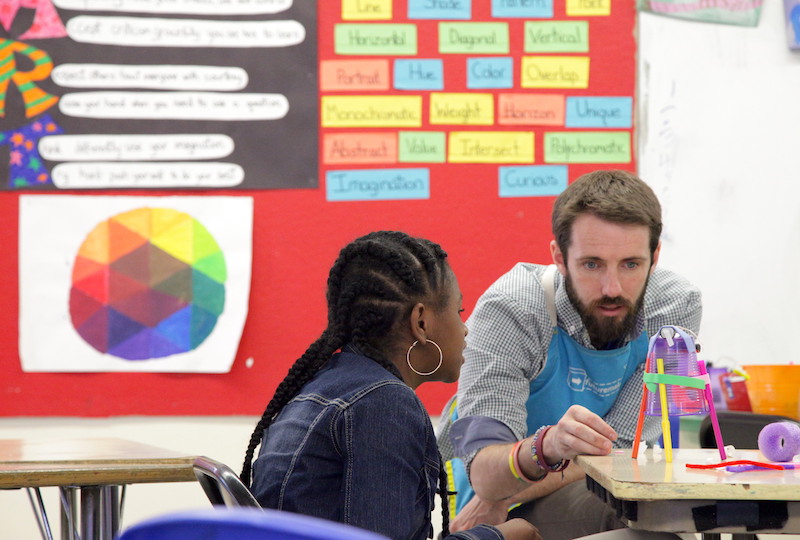
Coach Topher raised his hand at the front of the classroom and asked, “Who here has ever made something before?” The kids were excited. Some of the materials they received to build their machines, they recognized. Some, they did not. All of them, they had to connect and make work.
Problem-solving and troubleshooting are easy to talk about. “It’s easy to say, ‘try your best,’ but in the moment, it’s the most frustrating thing.” Connecting batteries to motors and transforming them into pieces of art takes patience and skill. “Engineers fix stuff. Usually, they’re fixing stuff they mess up themselves!”
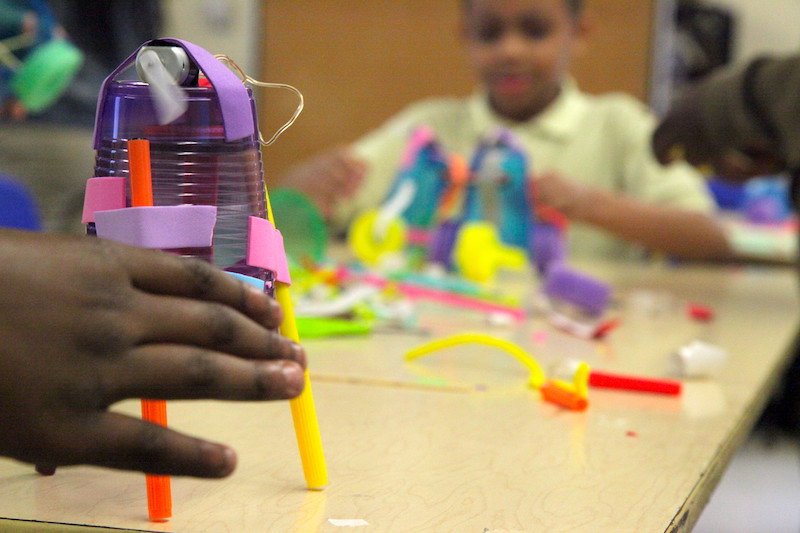
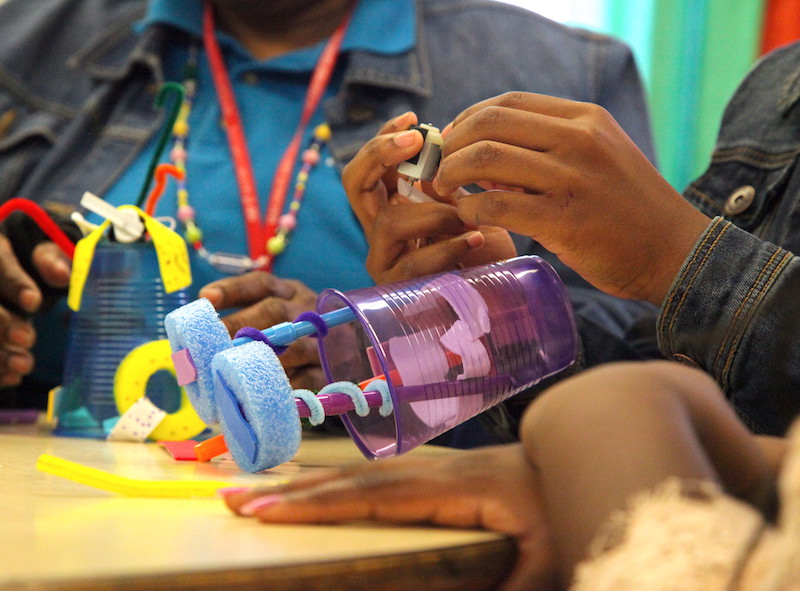
 Though students all started on the same path, each robot took on its own distinct personality. Students directed the design of their bots, testing and retesting to see how design elements worked with the functionality of their machines. Through problem solving and teamwork, the young engineers found success.
Though students all started on the same path, each robot took on its own distinct personality. Students directed the design of their bots, testing and retesting to see how design elements worked with the functionality of their machines. Through problem solving and teamwork, the young engineers found success.
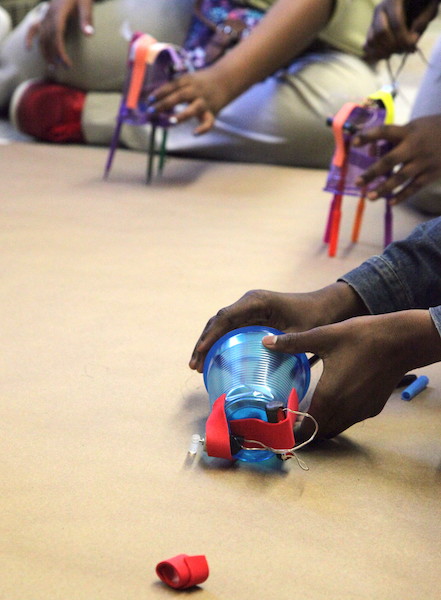
“FutureMakers knows that integrating quality STEAM programs is essential – and requires support,” said Barinholtz. Funding is available for schools and community organizations that can help all children experience high-quality arts programs.
Bring FutureMakers into your school with the help of a Maryland State Arts Council (MSAC) Arts in Education (AiE) grant. The MSAC AiE grant will fund up to 30% of the total cost of a YA residency program, including travel costs. The deadline to apply is Friday, May 19, 2017, by 5 pm. Start the application process today.










